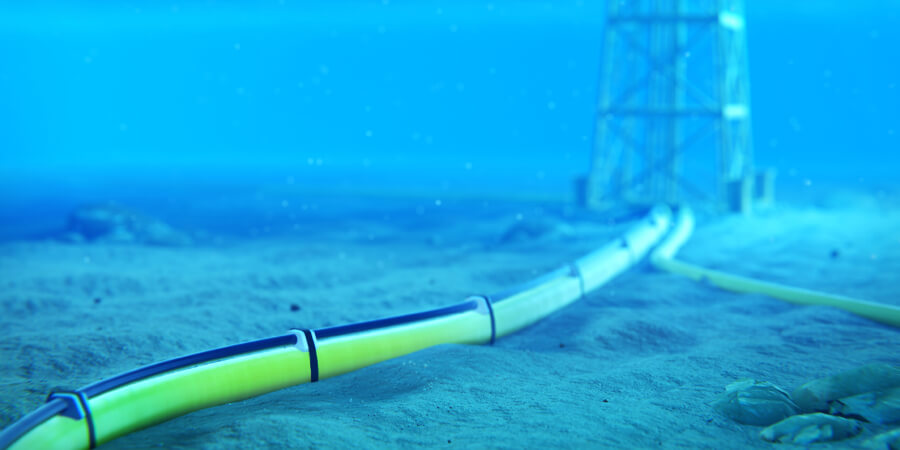A submarine communication cable is a fiber-optic cable constructed underwater to connect two or more landing locations. Today's cables typically consist of optical fibers that carry information. These fibers are then covered in silicon gel and sheathed in various layers of plastic, steel wiring, copper and nylon to provide insulation for the signal and shield the cable from damage from animals, anchors, fishing, weather and other natural occurrences. Submarine cables are designed to offer high bandwidth and low latency. They provide high reliability and greater security, as they are difficult to tap into.
According to analyst firm TeleGeography, there are currently a total of 552 submarine cables in service or under construction globally, spanning roughly 1.4 million kilometers (km) and transmitting over 95% of global data traffic. "The whole network of undersea cables is the lifeblood of the economy," explains Alan Mauldin, an analyst with TeleGeography. "It's how we're sending emails and phone calls and YouTube videos and financial transactions."
These cables are of significant importance, especially in Southeast Asia, as the region hosts many emerging economies with surging bandwidth demand. The Asia-Pacific (APAC) region generally has more island and archipelago nations than any other region worldwide, and for this reason, submarine cables are an essential infrastructure. There are several key submarine cable projects currently underway, totaling an estimated $2.6 billion, that are expected to be finished by 2025. They are as follows:
Southeast Asia-Japan Cable 2
The Southeast Asia–Japan 2 (SJC2) submarine cable system spans 10,500 km, connecting a total of 11 cable landing stations in Singapore, Thailand, Cambodia, Vietnam, Hong Kong, Taiwan, China, Korea and Japan. This new cable edition, introduced in 2013, aims to add extra capacity to the route served by the first SJC, the initial system that was finished in 2013.
The SJC2 cable has eight fiber pairs and at least 18 terabytes per second (Tbps) of capacity per fiber pair, with an initial design capacity of 144 Tbps. The SJC2 consortium consists of China Mobile International (CMI), Chuan Wei, Chunghwa Telecom (CHT), Donghwa Telecom (DHT), Facebook, KDDI, Singtel, SK Broadband (SKB), Telin, TICC (True) and VNPT.
The initial cost of the SJC2 cable system is estimated at around $440 million. The project is expected to be completed in 2024.
Asia Link Cable
The Asia Link Cable (ALC) is approximately 6,000 km in length and is planned to run through the South China Sea. It was established by a pan-Asian consortium including Singtel, China Telecom Global, CTC, Global Telecom, DITO and Unified National Networks.
The ALC project has an expected cost of $300 million. It was announced in 2022 and is scheduled for completion by 2025. "ALC is a great accomplishment of Asian carriers, which overcame difficulties of COVID impacts, and it is also the only subsea project with zero face-to-face meetings from the memorandum of understanding to the construction and maintenance agreement signing in the industry," notes Chang Weiguo, co-chair of ALC (CTG).
The ALC cable system will have a minimum of eight fiber pairs, with an 18 Tbps per fiber pair minimum trunk design capacity. This will give more capacity and variation to existing networks in the region.
SEA-ME-WE 6
The SEA-ME-WE 6 (South East Asia-Middle East-West Europe 6, or SMW6) is a 19,200 km submarine cable system between Singapore and France (Marseille) and crosses Egypt through terrestrial cables.
This sixth version will cost around $500 million to finish and is set for completion in 2025. Its two subsea components will run from Singapore to Ras Ghareb in Egypt and then from Port Said to Marseille. The cable will run 10 fiber pairs at 12.6 Tbps per pair, with the potential for up to 24 fiber pairs per line in the future.
The SMW6 consortium includes Bangladesh Submarine Cable Company Limited (BSCCL), Bharti Airtel Ltd. (India), Dhivehi Raajjeyge Gulhun Public Limited Company (Dhiraagu Maldives), China Unicom (China), Djibouti Telecom, Mobily (Saudi Arabia), Orange (France), Singtel (Singapore), Sri Lanka Telecom, Telecom Egypt, Telekom Malaysia, Telin (Indonesia) and Trans World Associates (Pakistan). It was previously reported that China Telecom and China Mobile, who had shown initial interest, had subsequently withdrawn their investments in SEA-ME-WE 6.
SEA-ME-WE 6 is a remarkable project, continuing a storied history. It is the latest iteration of a subsea cable that was introduced in 1984. A consortium of 22 operators from 21 countries completed work on SEA-ME-WE 1 in 1985, costing more than $600 million at the time. The system was originally one of the longest submarine cables in the world at 13,000 km, with eight segments linking Singapore to France via Indonesia, Sri Lanka, Djibouti, Saudi Arabia, Egypt and Italy.
These are just some of the submarine cable system projects in Asia that are now in the spotlight.
According to Research and Markets, the Asia Pacific submarine cable system market is projected to grow at a CAGR of 12.8% from $235.85 million in 2021 to $546.78 million by 2028. Submarine cable deployments in Asia have seen a significant increase due to the region’s rising demand for data. And with such a focus on this necessary infrastructure, Asia is poised to meet that demand.





